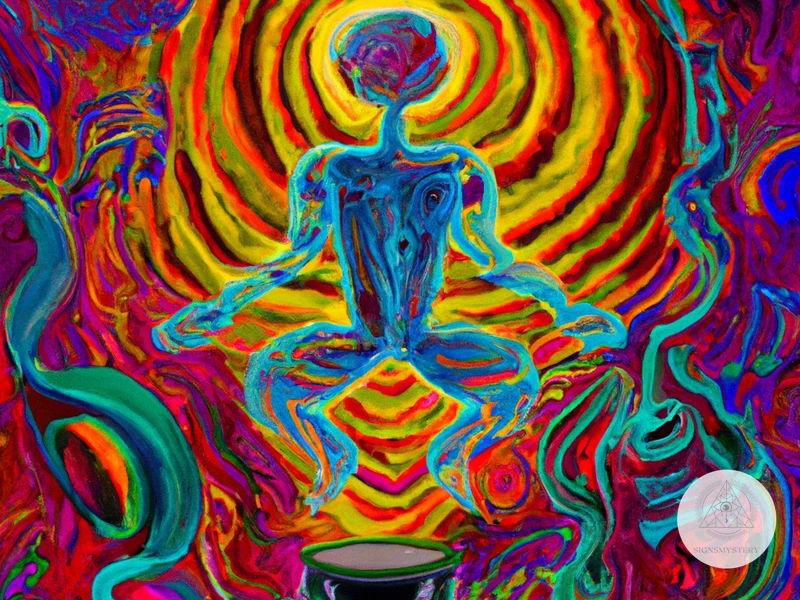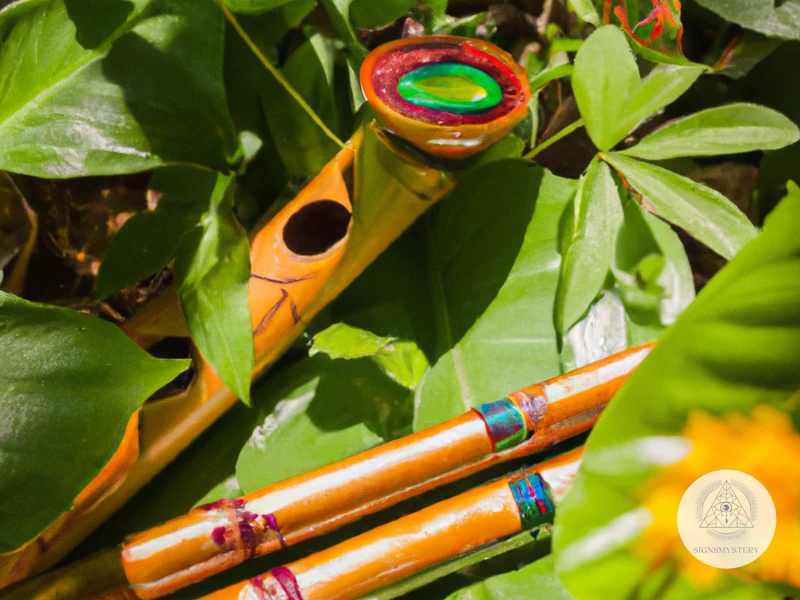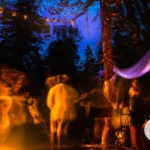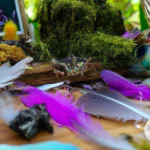Shamanic traditions have been around for centuries and are still practiced in various parts of the world. Central to shamanic practices is the use of music and sound to facilitate healing, connection to the spirit world, and altered states of consciousness. In South America, indigenous shamanic communities have used music and sound in their ceremonies for thousands of years. However, as modernization and globalization impact traditional cultures, there is a need for respectful preservation and appropriation of such practices. This article explores the intricate relationship between music, sound, and shamanic ceremonies in South America, and delves into the power of rhythm, intention, and intuition in creating transformative experiences.
What is Shamanism?
Shamanism is a spiritual practice that has been around for thousands of years and is found in many different cultures around the world. In South America, shamanism has been a part of the indigenous culture for centuries and has survived despite the influences of colonization and modernization.
At its core, shamanism is a practice that allows individuals to connect with the spiritual world and to work with the energies and spirits of the natural world. Traditional shamans are regarded as healers, using their knowledge and skills to promote healing and balance in their communities.
Shamanism is often associated with the use of psychotropic plants and other substances, which can help to facilitate altered states of consciousness. In many South American shamanic traditions such as the Ayahuasca ceremony, these plants are used to deepen spiritual experiences and access spiritual dimensions. However, not all shamanic rituals require the use of these substances, and there are many forms of shamanism that do not incorporate them at all.
Shamanism is also closely connected to the natural world, with many shamanic rituals and practices involving the use of plants and animals that are considered sacred. Traditional shamanism in South America is often divided into two categories: Andean and Amazonian shamanism. Each of these categories has its own unique practices and cultural traditions. To learn more about the differences between Andean and Amazonian shamanism, visit the related article.
Some of the core practices of shamanism include shamanic journeying, which involves entering altered states of consciousness to access spiritual realms, and soul retrieval, which involves the shaman locating and retrieving lost soul fragments from individuals who have experienced trauma or illness. To learn more about these practices, visit the related articles on soul retrieval and shamanic journeying.
Despite the many challenges that shamanism has faced throughout history, the practice continues to be an important part of many indigenous cultures in South America. As with all cultural practices, it is important to approach shamanism with respect and a willingness to learn. To learn more about the evolution of shamanism in South America and its relationship with Catholicism and colonization, visit related article.
The Role of Music and Sound in Shamanic Traditions
In shamanic traditions, music and sound play a fundamental role in inducing altered states of consciousness and facilitating connection with the spiritual realm. It is believed that the vibrations and frequencies of certain sounds can activate different parts of the brain, allowing the shaman to enter into a trance-like state that enables them to communicate with spirits and access higher realms of consciousness.
Music and sound are also used to create a sacred and ceremonial atmosphere that is conducive to spiritual transformation. In many shamanic communities, particular instruments and vocal techniques are reserved solely for ceremonial purposes and are not used in everyday life. This helps to build a sense of reverence and respect for these sacred practices and cultivates a deep connection to the spiritual world.
In South American shamanic traditions, music and sound are often used in conjunction with plant medicine. Shamans use specific songs and icaros (spiritual melodies) to guide individuals through the healing process during ayahuasca ceremonies. These songs are believed to have unique healing properties and are sung with the intention of healing specific physical, emotional, or spiritual ailments.
Furthermore, music and sound are also used to connect with the natural world. In shamanic communities, the relationship between humans and nature is seen as sacred and deeply interconnected. Shamans use music and sound to communicate with the spirits of the natural world and perform rituals that honor the cycles and rhythms of nature.
The use of music and sound in shamanic traditions serves a multifaceted purpose – from inducing altered states of consciousness to creating a sacred ceremonial atmosphere, music and sound play a vital role in South American shamanism.
Music and Consciousness

The Power of Rhythm and Repetition
Music has been used for centuries as a tool for altering consciousness, and this is particularly evident in shamanic practices. Shamanic music often incorporates repetitive rhythms that induce a trance-like state in the listener. The use of strong, steady beats is thought to help synchronize brainwaves and induce a state of heightened awareness and altered consciousness.
Interestingly, research has shown that certain types of rhythmic music can actually help to reduce anxiety and promote relaxation. One study found that listening to rhythmic drumming for just 30 minutes can lead to a decrease in stress hormones such as cortisol.
The Importance of Intention and Intuition
In shamanic music, the intention of the musician is an essential element. During shamanic ceremonies, music is often used to “call in” spirits or entities, and the intention of the musician and the participants is thought to be vital in creating a safe and sacred space.
Similarly, musicians often rely on their intuition when creating shamanic music. The use of improvisation and spontaneity allows for the music to flow organically and can result in powerful emotional experiences for both the musician and the listener.
The Use of Musical Instruments and Vocal Techniques
Shamanic music often incorporates a range of unique instruments such as drums, rattles, flutes, and various stringed instruments. These instruments are usually handmade and are crafted specifically for shamanic purposes. The use of specific instruments can be symbolic within shamanic tradition, and each instrument has its own unique sound and energy.
Vocal techniques, such as chanting, are also often used in shamanic music. These techniques can produce a range of different effects, including the induction of trance-like states, the enhancement of spiritual connection, and the promotion of emotional release.
It is the combination of rhythm, intention, and intuition that makes shamanic music such a powerful tool for enhancing consciousness and spiritual connection. As shamanism continues to evolve and adapt, it is likely that we will see new forms of shamanic music emerge that build upon these ancient traditions.
Ayahuasca ceremonies in particular have become increasingly popular in recent years, and musicians are experimenting with new ways to incorporate music into these ceremonies to enhance the experience for participants. It’s important to recognize the value of these traditional musical practices and to continue to honor and preserve them as they continue to evolve in the modern world.
The Power of Rhythm and Repetition
The use of rhythm and repetition is a key component in South American shamanic ceremonies. Shamanic practitioners believe that the combination of repetitive drumming, rattling, singing, and chanting can alter consciousness and allow individuals to connect with the spiritual realm.
The Power of Rhythm:
The use of a drum is one of the most prevalent instruments used in shamanic ceremonies. The steady, rhythmic beat of the drum can create a trance-like state, allowing individuals to journey through different levels of consciousness. This is because the sound of the drum alters brainwaves, slowing them down to states of relaxation and meditation. This is especially effective when the drumming is carefully timed, as it can mimic the natural rhythms present in the environment. By doing so, it can help individuals connect with the energies that surround them and enter a state of heightened awareness.
The Importance of Repetition:
Repetition is also a significant component in shamanic ceremonies. The repetition of sounds, words or chants helps to focus the mind and enhance intentions. It can have psychological and physiological effects, as it can help to soothe and restore a sense of calm. Repetitive singing or chanting can also change one’s personal frequency, providing an opportunity to align with higher energy states. The use of mantras, which are considered sacred sounds, can have a profound effect on the mind, body, and spirit.
The Combination of Rhythm and Repetition:
Combining rhythm and repetition can create a unique environment that is conducive to spiritual exploration. By doing so, individuals can tap into the realm of the divine and connect with their inner selves. The use of fast rhythms, for example, can create a sense of excitement and induce a natural “high,” while slower rhythms can create a feeling of relaxation and contemplation. The combination of both can create a powerful and transformative experience that can be healing and enlightening.
The power of rhythm and repetition is an integral part of South American shamanic ceremonies. By combining different sounds, rhythms, and techniques, individuals can connect with the spiritual realm and enter into states of consciousness that can promote physical and emotional healing. It is an ancient practice that is still used today in contemporary shamanic traditions.
If you’re interested in learning more about the shamanic traditions of South America, check out our article on Community Shamanism in South America. Additionally, if you’d like to learn about the evolution of shamanism in this region, read our piece on the Evolution of South American Shamanism.
The Importance of Intention and Intuition
In shamanic traditions, intention and intuition play a crucial role in the use of music and sound. Intention is the conscious direction of one’s will towards a specific goal, while intuition is the ability to access deeper levels of knowledge and understanding beyond the rational mind. These two aspects work together to create a powerful tool for shamanic practitioners.
The Importance of Intention:
Intention is a key element in shamanic music and sound because it directs the energy in a particular direction. The intention could be to connect with a specific spirit, to heal a particular illness, or to create a certain emotional state. Whatever the intention, the intention sets the tone for the music and sound that follows.
In shamanic ceremonies, the intention is often set at the beginning through various rituals or prayers. The shaman or practitioner may also use specific words or phrases to invoke a specific intention. For example, in an Ayahuasca ceremony, the shaman may set the intention for healing, transformation, or spiritual guidance. The music and sound that follows is then used to enhance and amplify that intention.
The Importance of Intuition:
Intuition allows the shamanic practitioner to connect with deeper levels of consciousness and access information beyond the rational mind. Through intuition, the shaman can understand the needs of the individual or group they are working with and use music and sound to address those needs.
Intuition also allows the shaman to improvise and adapt the music and sound to the needs of the moment. For example, if an individual is experiencing a particular emotion or physical sensation, the shaman may intuitively choose a specific rhythm or melody that helps to release that emotion or sensation.
There are no set rules when it comes to shamanic music and sound. It is a highly intuitive process that requires the shaman to be in a state of deep listening and presence. The music and sound that emerges from this state is often spontaneous and unique to the individual or group being worked with.
The Importance of Intention and Intuition in Practice:
The importance of intention and intuition in shamanic music and sound is perhaps best illustrated in the icaros of the Shipibo-Conibo people of the Amazon in Peru. Icaros are songs sung by shamans during Ayahuasca ceremonies, and each icaro has a specific intention and melody.
The shamans who sing icaros use their intuition to choose the right song for the individual or group they are working with. The icaros are also improvised, with the shaman using their intuition to change the melody and rhythm to suit the needs of the moment.
In this way, intention and intuition work together to create a highly effective tool for shamanic practitioners. By setting a clear intention and tuning into their intuition, shamanic practitioners can use music and sound to create powerful transformative experiences for themselves and those they work with.
The Use of Musical Instruments and Vocal Techniques
Musical instruments and vocal techniques have been integral to shamanic ceremonies in South America for centuries. These tools are used to induce altered states of consciousness, create a sacred environment, and connect with spiritual energies.
The Use of Musical Instruments
There are a variety of musical instruments utilized in shamanic ceremonies. Each instrument has a unique sound and purpose. Here are some examples:
| Instrument | Purpose |
|---|---|
| Drums | Used to create a consistent rhythm that induces a trance-like state. The drumbeat represents the shaman’s heart and is believed to connect them with the spirit world. |
| Rattles | Used to create a higher-pitched sound that complements the deeper sound of the drums. The shaking of the rattles represents the movement of energy and is believed to help the shaman communicate with spirits. |
| Flutes | Used to create a calming, meditative sound. The sound of the flute is believed to evoke a sense of peace and tranquility, which is helpful for healing ceremonies. |
| Didgeridoos | Used to create a deep, resonant sound that can induce a trance-like state. The sound of the didgeridoo is believed to have a cleansing effect on the body and mind. |
Vocal Techniques
Shamans also use their voice as a tool to create a sacred atmosphere and connect with spiritual energies. Here are some common vocal techniques used in shamanic ceremonies:
- Chanting: The shaman may chant repetitive sounds or words to create a trance-like state and connect with spirits.
- Singing: The shaman may sing songs that have been passed down through generations. These songs often have specific meanings and are believed to evoke the energies of various elements and forces in nature.
- Toning: The shaman may make sustained vocal sounds to create a vibrational frequency that can help align the body and mind with spiritual energies.
- Humming: The shaman may hum to create a low, calming sound that can help induce a state of relaxation and receptivity.
The use of musical instruments and vocal techniques in shamanic ceremonies is a powerful way to create a sacred environment, induce altered states of consciousness, and connect with spiritual energies.
Sound and Healing
Shamans believe that music and sound have a profound effect on the mind, body, and spirit. In South American shamanic traditions, music and sound are used to promote healing and restore balance to the individual and the community.
Sound waves can have a powerful effect on the physical body. It has been shown that certain frequencies can stimulate the release of endorphins, decrease stress, and promote relaxation. These effects can be especially beneficial for those suffering from chronic pain, anxiety, and depression.
Additionally, sound waves are believed to affect the energy centers, or chakras, within the body. These chakras are believed to be linked to different emotional, physical, and spiritual qualities. By stimulating these energy centers with sound, it is believed that imbalances can be corrected and the body can return to a state of harmony.
Shamans use a variety of musical instruments and vocal techniques in their healing ceremonies. Perhaps the most well-known instrument used in shamanic rituals is the drum. The steady beat of the drum is believed to induce a trance-like state, where the individual can access deeper levels of consciousness.
In addition to the drum, rattles, flutes, and other instruments are also used in shamanic ceremonies. Chanting, singing, and humming are also common vocal techniques used to create a healing atmosphere.
It is important to note that shamanic healing is not meant to replace traditional medical treatment, but rather to complement it. Some shamans may work in conjunction with medical professionals to provide a holistic approach to healing.
Here is a list of some common sound healing techniques used by shamans:
- Drumming: The steady beat of the drum is believed to induce a trance-like state.
- Rattling: Rattles are often used in combination with drumming, and are believed to help move energy through the body.
- Singing: Shamans may use traditional songs or create their own melodies to promote healing.
- Chanting and humming: These techniques are used to create a calming atmosphere and promote relaxation.
- Breathwork: Some shamans may incorporate breathing exercises into their healing ceremonies to promote increased oxygenation and relaxation.
The Use of Sound and Technology in Healing
In recent years, there has been an increased interest in the use of sound technology for healing purposes. This has led to the development of devices such as sound beds and vibrational therapy tools. These devices use sound frequencies to promote relaxation and healing.
One example of this is the use of binaural beats. Binaural beats are created when two different frequencies are played simultaneously, creating a third frequency that is believed to promote relaxation and deep meditation.
While the use of technology for healing has its place, it is important not to lose sight of the traditional methods used by shamans. The connection between the healer, the individual, and the music is an important aspect of shamanic healing that cannot be replicated by a machine.
Sound and music play a powerful role in South American shamanic ceremonies and healing practices. By understanding the connection between sound and the body, and the use of sound healing techniques, we can better appreciate the healing power of music and its ability to promote balance and harmony within the individual and the community.
The Connection between Sound and the Body
The connection between sound and the body in shamanic traditions is a fundamental aspect of the healing process. The use of sound and music in shamanic ceremonies is believed to stimulate the body’s natural healing mechanisms, promoting physical, emotional, and spiritual well-being.
Vibrational Energy
One of the primary ways in which sound affects the body is through vibrational energy. Sound waves travel through the air and stimulate the body’s cells, organs, and tissues. This vibrational energy is believed to have a therapeutic effect on the body, helping to release emotional and physical blockages and promoting the flow of vital energy throughout the body.
The Science of Sound Healing
While the use of sound for healing purposes has been a part of shamanic traditions for centuries, there is now a growing body of scientific research that supports the effectiveness of sound healing. Studies have shown that certain types of sound frequencies can have a measurable impact on the body, producing changes in brain waves, heart rate, and other physiological functions.
Biofeedback
In shamanic ceremonies, sound is often used to induce a state of deep relaxation and meditation, allowing participants to access their body’s own natural healing process. By using sound as a form of biofeedback, shamanic practitioners can help their clients to become more aware of their own physical and emotional states, making it easier to release tension and stress and promote healing.
The Chakra System
Another aspect of the connection between sound and the body in shamanic traditions is the concept of the chakra system. According to this traditional belief, the body is made up of seven energy centers, or chakras, each of which is associated with a different aspect of physical, emotional, or spiritual health. By using sound frequencies that correspond to each chakra, shamanic practitioners believe that they can stimulate the body’s natural healing process and promote overall well-being.
The connection between sound and the body in shamanic traditions is a complex and powerful aspect of the healing process. By understanding and harnessing the therapeutic power of sound, shamanic practitioners can help their clients to achieve greater physical, emotional, and spiritual health and well-being.
The Use of Sound Healing Techniques in Shamanic Ceremonies
The use of sound healing techniques in shamanic ceremonies is an ancient practice that is still widely used today. Shamans believe that sound and vibration have the power to heal the body and mind, and they use various instruments and vocal techniques to produce these healing sounds.
One common instrument used in shamanic sound healing is the drum. The repetitive rhythm of the drum is believed to induce a trance-like state that allows the participant to access deeper levels of consciousness. In this altered state of consciousness, the shaman is able to communicate with the spirit world and perform healing for the participant.
Another instrument used in shamanic sound healing is the rattle. The sound of the rattle is used to clear negative energy from the body and to harmonize the energy centers or chakras. The shaman may also use vocal techniques such as chanting or toning to produce healing sounds that resonate with the body and promote healing.
In addition to instruments and vocal techniques, shamans also use sound baths during ceremonies. Sound baths involve participants lying down while the shaman plays a variety of instruments including singing bowls, gongs, and chimes. The vibrations from these instruments are believed to balance the energy in the body and promote healing.
Shamans also use icaros, which are traditional songs used in shamanic ceremonies to connect with the plant spirits. The icaros are believed to have healing properties and are used to facilitate communication with the spirit world.
The use of
Subscribe to Our Newsletter
Sign up to receive the latest news and updates.
Music and Plants

Plants play a vital role in shamanic traditions as they are believed to possess consciousness and spiritual power. In many traditional South American ceremonies, plants are used in combination with music to unlock their healing and transformative properties.
In shamanic traditions, plants and music are considered to be interconnected. Shamans believe that plants possess a unique form of intelligence and consciousness and are capable of communicating with humans through the power of music. Each plant is said to have its own unique spirit, or “plant teacher,” that can be accessed through the use of specific musical frequencies.
One of the most well-known plant medicines used in shamanic ceremonies is ayahuasca, a brew made from the ayahuasca vine and other plants. Ayahuasca is known for its powerful healing and transformative properties and is often consumed in combination with music.
During an ayahuasca ceremony, the shaman, or “ayahuasquero,” will sing icaros, which are traditional songs that are believed to possess the power to heal and transform. These songs are said to be taught to the shaman by the plants themselves and are used to communicate with the plant spirits and guide the participants through the ayahuasca experience.
The music and plant medicine work together to create a transformative and healing environment that is believed to help participants connect with their inner selves, the natural world, and the spirit world.
The relationship between music and plants in shamanic traditions highlights the interconnectedness of all living beings and the importance of using music and plant medicine in a respectful and intentional manner.
The Relationship between Plants and Music in Shamanic Traditions
Shamanic traditions place a strong emphasis on the use of plant medicine during ceremonies, and the relationship between plants and music is a vital aspect of these practices. The indigenous people of South America believe that plants have capabilities beyond our limited understanding, and certain plants possess spirits that can communicate with humans.
The use of plants during shamanic ceremonies is often accompanied by music, as the combination of the two heightens the overall experience. Certain plants are believed to have a musical quality to them, and shamanic healers use this quality to facilitate a deeper connection with the plant’s spirit.
In some cases, certain musical instruments are created by using plants, such as the maracas, which are made from dried and hollowed-out gourds filled with beans or seeds. The music produced by these instruments is believed to enhance the properties of the plants used during the ceremony.
Shamanic healers also use music to connect with plants on a deeper level, as music is believed to have the ability to invoke plant spirits. Music can alter the state of consciousness of those involved in the ceremony, allowing them to more easily communicate with spirit entities and access the healing properties of the plants used in the ceremony.
The relationship between plants and music in shamanic traditions is a vital aspect of the ceremonies. The combination of the two is believed to enhance the overall experience and facilitate a deeper connection with the spirit world. The use of music is just one way in which shamanic healers tap into the power of plants, and it is yet another example of the intricate relationship between humans and the natural world.
The Use of Plant Medicine and Music in Ayahuasca Ceremonies
Ayahuasca is a powerful plant medicine that is used in shamanic ceremonies throughout South America. It is brewed from the Ayahuasca vine and the leaves of the Chacruna plant, and its use dates back thousands of years. Ayahuasca is known for its powerful psychoactive effects, which can lead to profound spiritual experiences and profound healing.
Music and sound play an important role in Ayahuasca ceremonies, as they are used to guide and support participants through their journey. The use of music in these ceremonies is highly ritualized, with specific songs and rhythms used for specific purposes, such as calling in protective spirits or guiding participants through difficult experiences.
The Role of Music in Ayahuasca Ceremonies:
Music is an integral part of the Ayahuasca experience, serving as a tool for healing, transformation, and spiritual connection. The songs used in Ayahuasca ceremonies are called icaros, which are traditional shamanic songs that are often learned directly from the plants themselves. Icaros are typically sung by the shaman and other participants, and they are used to set the intention for the ceremony, call in protective spirits, and provide guidance and support throughout the journey.
The Use of Sound Healing in Ayahuasca Ceremonies:
In addition to traditional icaros, some Ayahuasca ceremonies also incorporate sound healing techniques. These may include the use of singing bowls, gongs, or other musical instruments, as well as chanting or toning.
These sound healing techniques are believed to have a powerful effect on the body and mind, helping to open up energetic blockages, release negative emotions, and promote deep relaxation and healing. Some Ayahuasca facilitators also use specially designed soundscapes to create a supportive and nurturing environment for participants.
The Relationship Between Plants and Music in Ayahuasca Ceremonies:
Ayahuasca ceremonies often involve a deep connection with the plants themselves, and music is seen as a powerful way to facilitate this connection. Many shamanic traditions believe that plants have their own unique spirits, and that these spirits can be communicated with through music and sound.
Some shamans also use tobacco or other sacred plants as part of their ceremonies, and these plants may also be smoked or ingested in combination with Ayahuasca. The use of these plants is seen as a way to deepen the connection with the natural world and to access the wisdom and healing that these plants hold.
The use of plant medicine and music in Ayahuasca ceremonies is a powerful and transformative practice that has been used for thousands of years. While the specifics of these ceremonies may vary from tradition to tradition, the underlying belief in the healing power of music and plant medicine remains central to all shamanic practices.
The Future of Shamanic Music
Shamanic music has been around for centuries and has played an integral role in the traditions and rituals of indigenous people. However, with the modernization of the world, the future of shamanic music is uncertain. What does the future hold for this ancient art form?
As the world becomes more technological, the traditional ways of indigenous people are being threatened. The use of traditional instruments and vocal techniques has been declining due to the introduction of modern instruments and electronic music. This has caused a divide within the indigenous communities, with some embracing modernization while others strive to hold on to their traditions.
It is important to recognize and respect the history and cultural significance of shamanic music. The preservation of traditional music and instruments should be a priority for the next generation. This paves the way for respectful appropriation which acknowledges the value of shamanic music and its place in the modern world.
Respectful appropriation means that artists are encouraged to use elements of shamanic music in their works, while at the same time ensuring that the authenticity and significance of the traditional music are not lost. The benefit of this is that it can help to introduce shamanic music to a wider audience and promote its relevance in today’s society.
The future of shamanic music depends on our willingness to respect and preserve the traditions of indigenous people. As a society, we need to recognize the value of traditional music and the importance of its preservation. With respectful appropriation, shamanic music can continue to inspire and influence, while maintaining its authenticity and cultural significance.
The Impact of Modernization on Shamanic Music
With the globalization and modernization of our world, shamanic music has begun to face some changes. The impact of modernization on shamanic music has been a topic of discussion and controversy among scholars and practitioners alike. Some argue that modernization threatens the authenticity and purity of shamanic music, while others believe that it brings new opportunities for innovation and creativity.
One aspect of modernization that has affected shamanic music is access to technology and new musical instruments. While traditional shamanic music was often created using only natural materials and instruments, such as drums made from animal skins and rattles made from gourds or seeds, modern technology allows for the creation of new instruments with unique sounds and capabilities. This has resulted in a fusion of traditional and modern musical styles, with some shamanic practitioners incorporating electronic beats or synthesizers into their music.
Another impact of modernization on shamanic music is the influence of globalization and cultural exchange. With increased travel and communication, traditional shamanic music is no longer limited to its place of origin. Musicians and practitioners from different parts of the world are now able to learn from each other and incorporate new styles into their own shamanic music. This has led to a diversification of shamanic music, with new subgenres emerging.
At the same time, the impact of modernization on shamanic music has also raised concerns about cultural appropriation and commodification. Some argue that the commercialization of shamanic music and its integration into mainstream music and entertainment industries can strip it of its spiritual and cultural significance. Others worry that the appropriation of shamanic music by non-indigenous people can be disrespectful and erode indigenous cultural heritage.
Ultimately, the impact of modernization on shamanic music is complex and multifaceted. It presents both opportunities and challenges for the preservation and evolution of shamanic music. It is up to shamanic practitioners and scholars to navigate these changes with respect to the tradition and cultural heritage of shamanic music.
The Need for Respectful Appropriation and Preservation of Traditional Shamanic Music
Traditional shamanic music is a powerful and sacred art form that has been passed down from generation to generation. However, in recent times, there has been a growing concern about the exploitation of shamanic music for commercial purposes. There is a need for a respectful appropriation and preservation of traditional shamanic music to ensure that this cultural heritage is not lost or diluted.
One of the major issues with the commercialization of shamanic music is that it can lead to cultural appropriation. This occurs when individuals or companies use elements of a culture that is not their own without proper understanding or respect. Shamanic music is often seen as a trendy and exotic genre, and this can lead to people appropriating it without acknowledging its cultural origins.
Another issue is the potential for misrepresentation and dilution of the traditional shamanic music. When shamanic music is used inappropriately or without understanding, it can lose its true meaning and become nothing more than a marketing tool. This can damage the authenticity and cultural significance of this music form, potentially leading to its eventual extinction.
To address these issues, there needs to be a greater understanding and appreciation of the cultural significance of shamanic music. This means that individuals and companies that wish to use shamanic music should do so respectfully and with a deep understanding of its cultural heritage. This includes acknowledging the origins of the music and ensuring that it is used appropriately and respectfully.
There is also a need to promote and preserve traditional shamanic music. This can be done by supporting and promoting traditional musicians and music producers who are working to preserve this art form. It also means encouraging younger generations to learn about and appreciate the cultural significance of shamanic music.
Traditional shamanic music is a valuable and sacred art form that must be respected and protected. We should all work together to ensure that this cultural heritage is not diluted or lost through inappropriate use or commercialization. By promoting and preserving traditional shamanic music, we can help to keep this important art form alive for future generations.
Conclusion
In conclusion, music and sound play an essential role in South American shamanic ceremonies. From the power of rhythm and repetition to the connection between sound and the body, music is a tool that shamans use to access altered states of consciousness, facilitate healing, and communicate with the spiritual realm.
It is crucial to recognize and respect the traditional use of shamanic music and sound and to be mindful of the impact of modernization on these ancient traditions. As the interest in shamanism and plant medicine continues to grow, it is essential to approach the incorporation of these practices into modern society with respect and responsibility.
One way to preserve traditional shamanic music is through documentation and education. By studying and learning from the music and techniques used in shamanic ceremonies, we can gain a deeper understanding of the role of music in healing and spiritual practices.
Furthermore, sound healing techniques, such as those used in shamanic ceremonies, are gaining recognition in the Western world for their potential as complementary therapies in conventional medicine. Research on the effects of sound on the body and mind is ongoing, and as our understanding of these relationships deepens, we may see the incorporation of sound healing methods into the mainstream healthcare system.
In conclusion, the use of music and sound in South American shamanic ceremonies offers a unique and valuable perspective on the power of sound and its ability to connect us with the spiritual realm and facilitate transformation and healing. It is up to us to approach these traditions with respect, responsibility, and openness to learning and growth.
Frequently Asked Questions
What is the origin of shamanic music?
Shamanic music dates back thousands of years and has its origins in indigenous cultures around the world. The specific sounds and instruments used vary depending on the region and traditions.
How does shamanic music affect the brain?
Shamanic music has been shown to increase brain wave activity, particularly in the alpha and theta ranges, which are associated with relaxation and meditation. This can lead to a state of heightened awareness and altered consciousness.
What types of instruments are used in shamanic music?
Common instruments used in shamanic music include drums, rattles, flutes, and singing bowls. Vocal techniques, such as chanting and overtone singing, are also commonly used.
Can shamanic music be used in Western medicine practices?
Shamanic music and sound healing techniques have been integrated into some Western medical practices, particularly in the field of music therapy. However, it is important to approach the use of shamanic music with cultural sensitivity and respect for its origins and traditions.
What is the role of intention in shamanic music?
Intention is an important aspect of shamanic music, as it can influence the energy and outcome of a ceremony. Shamanic musicians often set intentions for their music, which can range from healing and spiritual connection to invoking certain energies or deities.
What is Ayahuasca and how is it used in shamanic ceremonies?
Ayahuasca is a powerful plant medicine used in shamanic ceremonies primarily in South America. It is traditionally brewed into a tea and consumed as part of a ceremony led by a shaman. The music and sound in these ceremonies serve to guide the participants through their experiences with the medicine.
How can shamanic music be used as a tool for healing?
Shamanic music can be used to promote relaxation and reduce stress, as well as to facilitate emotional and spiritual healing. The vibrations and frequencies of the music can also be used to target specific areas of the body and promote physical healing.
What is the future of shamanic music?
The future of shamanic music is largely dependent on the preservation and respectfully appropriate use of traditional indigenous music. It is important to honor the cultural origins and significance of shamanic music while also allowing for its evolution and adaptation to modern contexts.
Can anyone participate in a shamanic ceremony?
Shamanic ceremonies should only be approached with respect and cultural sensitivity. It is important to seek out experienced and trained shamans and to honor the traditions and practices of the specific culture. Participation may also be restricted based on individual health or mental health concerns.
How does shamanic music differ from other forms of music therapy?
Shamanic music differs from other forms of music therapy in its specific cultural and spiritual contexts. While other forms of music therapy may focus on specific clinical outcomes, shamanic music is often used for spiritual and emotional healing and connection.










